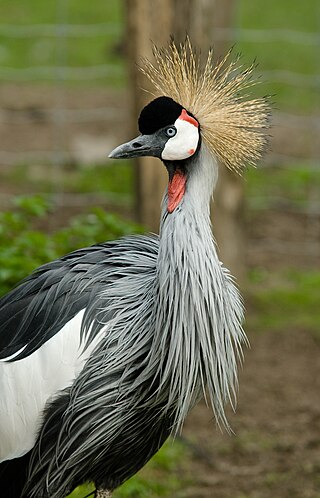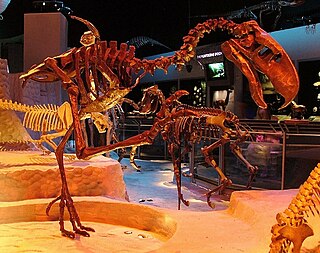
Birds of prey or predatory birds, also known as raptors, are hypercarnivorous bird species that actively hunt and feed on other vertebrates. In addition to speed and strength, these predators have keen eyesight for detecting prey from a distance or during flight, strong feet with sharp talons for grasping or killing prey, and powerful, curved beaks for tearing off flesh. Although predatory birds primarily hunt live prey, many species also scavenge and eat carrion.

The Gruiformes are an order containing a considerable number of living and extinct bird families, with a widespread geographical diversity. Gruiform means "crane-like".
Near passerines and higher land-bird assemblage are terms of traditional, pre-cladistic taxonomy that have often been given to tree-dwelling birds or those most often believed to be related to the true passerines owing to morphological and ecological similarities; the group corresponds to some extent with the Anomalogonatae of Alfred Henry Garrod.

Phorusrhacids, colloquially known as terror birds, are an extinct family of large carnivorous, mostly flightless birds that were among the largest apex predators in South America during the Cenozoic era. Their definitive fossil records range from the Middle Eocene to the Late Pleistocene around 43 to 0.1 million years ago, though some specimens suggest that they were present since the Early Eocene.

Titanis is a genus of phorusrhacid, an extinct family of large, predatory birds, in the order Cariamiformes that inhabited the United States during the Pliocene and earliest Pleistocene. The first fossils were unearthed by amateur archaeologists Benjamin Waller and Robert Allen from the Santa Fe River in Florida and were named Titanis walleri by ornithologist Pierce Brodkorb in 1963, the species name honoring Waller. The holotype material is fragmentary, consisting of only an incomplete right tarsometatarsus and phalanx, but comes from one of the largest phorusrhacid individuals known. In the years following the description, many more isolated elements have been unearthed from sites from other areas of Florida, Texas, and California. The species was classified in the subfamily Phorusrhacinae, which includes some of the last and largest phorusrhacids like Devincenzia and Kelenken.

Brontornis is an extinct genus of giant bird that inhabited Argentina during the Early to Middle Miocene. Its taxonomic position is highly controversial, with authors alternatively considering it to be a cariamiform, typically a phorusrhacid or an anserimorph.

Strigogyps is an extinct genus of prehistoric bird from the Middle Eocene to Early Oligocene of France and Germany. It was probably around the size of a large chicken or a guan, weighing not quite 1 kilogram (2.2 lb). Apparently, as indicated by the ratio of lengths of wing to leg bones, S. sapea was flightless. Its legs were not adapted to running, so it seems to have had a walking lifestyle similar to trumpeters. Unlike other Cariamiformes which appear to have been mostly carnivorous, the specimens of one species, Strigogyps sapea, suggest a facultatively herbivorous or omnivorous diet.

Kelenken is a genus of phorusrhacid, an extinct group of large, predatory birds, which lived in what is now Argentina in the middle Miocene about 15 million years ago. The only known specimen was discovered by high school student Guillermo Aguirre-Zabala in Comallo, in the region of Patagonia, and was made the holotype of the new genus and species Kelenken guillermoi in 2007. The genus name references a spirit in Tehuelche mythology, and the specific name honors the discoverer. The holotype consists of one of the most complete skulls known of a large phorusrhacid, as well as a tarsometatarsus lower leg bone and a phalanx toe bone. The discovery of Kelenken clarified the anatomy of large phorusrhacids, as these were previously much less well known. The closest living relatives of the phorusrhacids are the seriemas. Kelenken was found to belong in the subfamily Phorusrhacinae, along with for example Devincenzia.

Devincenzia is an extinct genus of giant flightless predatory birds in the family Phorusrhacidae or "terror birds" that lived during the Early Miocene (Deseadan) Fray Bentos Formation of Uruguay, Late Miocene (Huayquerian) Ituzaingó Formation, Early Pliocene (Montehermosan) of Argentina, and possibly the Early Pleistocene Raigón Formation of Uruguay. The type species D. pozzi was formerly known as Onactornis pozzi. The largest possible specimen weighed up to 350 kilograms (770 lb), making it one of the largest phorusrhacids and carnivorous birds known.

Patagornis is a genus of extinct flightless predatory birds of the family Phorusrhacidae. Known as "terror birds", these lived in what is now Argentina during the Early and Middle Miocene; the Santa Cruz Formation in Patagonia contains numerous specimens. Patagornis was an agile, medium sized Patagornithine and was likely a pursuit predator.
Paleopsilopterus is an extinct genus of giant flightless predatory birds within Cariamiformes. It is usually attributed to the subfamily Psilopterinae of the family Phorusrhacidae, or "terror birds", though doubts about such an identity have arisen multiple times. It lived around 53 to 50 million years ago (Itaboraian) in Brazil, during the Early Eocene. The only known species is Paleopsilopterus itaboraiensis. Fossils of Paleopsilopterus have been found in the Itaboraí Formation at São José de Itaborai in Rio de Janeiro state.
Namibiavis is an extinct genus of bird related to the hoatzin from early Middle Miocene deposits of Namibia. It was collected from Arrisdrift, southern Namibia. It was first named by Cécile Mourer-Chauviré in 2003 and the type species is Namibiavis senutae.

Cariamiformes is an order of primarily flightless birds that has existed for over 50 million years. The group includes the family Cariamidae (seriemas) and the extinct families such as Phorusrhacidae, Bathornithidae, Idiornithidae and Ameghinornithidae. Extant members (seriemas) are only known from South America, but fossils of many extinct taxa are also found in other continents including Europe and North America. Though traditionally considered a suborder within Gruiformes, both morphological and genetic studies show that it belongs to a separate group of birds, Australaves, whose other living members are Falconidae, Psittaciformes and Passeriformes.

Eleutherornis cotei is an extinct flightless predatory cariamiform bird which lived during the Middle Eocene of France and Switzerland. Since the early 20th century, researchers have initially described the fossils of Eleutherornis as separate taxa, some remains as a species of Gastornis and others as an ancient ratite related to modern ostriches. However, subsequent analyses have questioned the original interpretations, and a thorough reexamination in 2013 indicated that all of these described remains represent the same species.

Bathornithidae is an extinct family of birds from the Eocene to Miocene of North America. Part of Cariamiformes, they are related to the still extant seriemas and the extinct Phorusrhacidae. They were likely similar in habits, being terrestrial, long-legged predators, some of which attained massive sizes.
Paracrax is a genus of extinct North American flightless birds, possibly related to modern seriemas and the extinct terror birds. Part of Bathornithidae, it is a specialised member of this group, being cursorial carnivores much like their South American cousins, some species attaining massive sizes.

Bathornis is an extinct lineage of birds related to modern day seriemas, that lived in North America about 37–20 million years ago. Like the closely related and also extinct phorusrhacids, it was a flightless predator, occupying predatory niches in environments classically considered to be dominated by mammals. It was a highly diverse and successful genus, spanning a large number of species that occurred from the Priabonian Eocene to the Burdigalian Miocene epochs.
Elaphrocnemus is a genus of extinct bird from the Eocene and Oligocene periods of Europe. Part of Cariamiformes, its closest living relatives are seriemas, though it differs significantly from them, being a better flyer.
Dynamopterus velox is a prehistoric bird, known from a single large right humerus recovered in France. The humerus shares anatomical features with living cuckoos. It has also been classified in the suborder Cariamae in the Gruiformes.

Mirarce is a genus of enantornithe bird from the Late Cretaceous of Utah. It contains a single species, M. eatoni. It was similar in size to modern turkeys.















